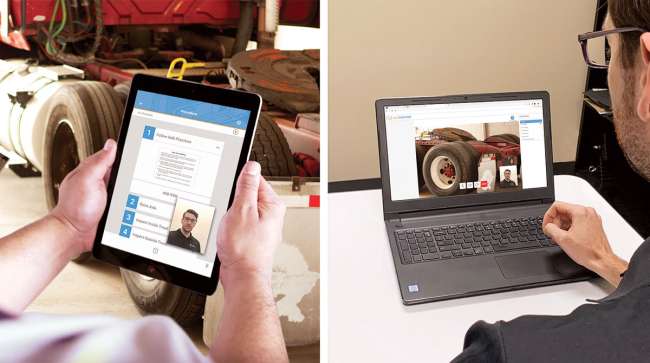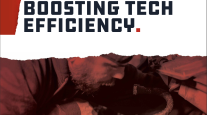Special to Transport Topics
Demand for Virtual Training Accelerates During Pandemic

[Ensure you have all the info you need in these unprecedented times. Subscribe now.]
Technician training is a critical part of a fleet’s maintenance routine, and in recent years, companies increasingly have added technology-based training techniques to their repertoire to supplement the gold standard of in-person training methods. The pandemic is accelerating this transition to virtual learning, and the industry might never turn back.
About seven years ago, Penske Truck Leasing launched an internal team dedicated to developing different methods for delivering information and training content to technicians. The team put a lot of effort into creating videos, and accumulated hundreds of clips available for technicians’ use, said Holly Gerke, Penske’s director of technical training.
Recently, the company began creating short videos — less than two minutes long — featuring Penske technicians in the shop offering tips to fellow maintenance employees.

Trainers strive to meet technicians where they are to provide the most effective learning opportunities. (Design Interactive)
“A lot of information may not always come from written procedures. It comes from technicians doing their job for a long time and having a great depth of knowledge,” Gerke said.
Videos and online virtual classroom learning are gaining popularity as a resource because of their convenience, especially compared with traditional methods such as consulting technical manuals. Videos provide a quick reference that technicians can easily watch via digital devices and then act on immediately.
“It’s a resource that technicians could access at the time of repair. They’re watching something quickly and seeing what tools to use [and] safety precautions to take to get whatever they’re working on done effectively and efficiently,” Gerke said.
Technicians increasingly are using video-sharing website YouTube as a platform for continuous learning considering the plethora of maintenance videos that exist there from a variety of sources. However, technicians should ensure that YouTube videos are posted by a reputable source and depict maintenance techniques compatible with their employer’s approach.
Virtual learning works both for in-house and third-party training. Some fleets prefer this method because it allows them to run the session on their own time with minimal disruptions. It also significantly reduces costs because little or no travel is required. Greg Johnsen, regional service manager at Maverick Transportation, said the company’s fleet has been doing online training for a while and has been challenging its suppliers to accommodate.
Meanwhile, the global coronavirus pandemic is prompting fleets to adopt technologies that allow training to continue without putting employees at risk of virus exposure from bringing in outside trainers, bringing together big groups of technicians or putting employees too close together.

Diesel Laptops put its in-person courses on pause early during the pandemic and cited an influx of people asking about online training. (Diesel Laptops)
“As this current pandemic evolves, I am sure more training will move to online,” Johnsen said. “[It’s] in everyone’s best interest.”
That very phenomenon is occurring. Diesel Laptops, a diagnostic hardware, software and maintenance training provider, put its in-person courses on pause early in the pandemic and had an “influx of people asking about online training. … Our team had to pivot quickly,” founder and CEO Tyler Robertson said.
Freeport, Ill.-based Quality Transport Co. regularly conducts orientation and safety training electronically through its learning management system, and it is “aggressively exploring options for virtual forms of continued education for our technicians,” said Amanda Schuier, the company’s senior vice president and chairman of the Technology & Maintenance Council’s S.5 Fleet Maintenance Management Study Group. TMC is a council of American Trucking Associations.
Remote Training During a Pandemic
Implementing new technologies within the workforce requires careful planning and analysis, which is one reason some fleets have not yet delved into digital training tools. But the pandemic rushed such decisions and changes in short order, creating difficulties for some fleets — especially smaller businesses with fewer resources at their disposal.
“This will, of course, create more challenges for companies: Do they have the hardware and software to facilitate this type of training? Which type of online meeting software will be utilized? Can this be standardized?” Johnsen said.

Penske experienced challenges when trying to expand its video conferencing and remote training capabilities early in the pandemic. The company contacted a computer camera vendor only to discover a 16,000-camera backlog due to surging demand that would significantly delay Penske’s order. Similar stories exist throughout trucking because most industries scrambled to upgrade their digital presence to accommodate states’ stay-at-home orders and the Centers for Disease Control and Prevention’s social distancing guidelines.
Another key challenge for virtual technician training is to keep the sessions engaging. While many in-person sessions offer a combination of classroom and hands-on learning, that’s harder to accomplish in a digital format.
Scott Meek, diesel technology instructor at Diesel Laptops, contended that diesel technicians prefer hands-on much more than sitting through PowerPoint slides or a lecture. Therefore, he noted, trainers strive to meet technicians where they are to provide the most effective learning opportunities.
Not every truck system or maintenance task translates well to a digital format. Systems that are complex in nature, such as hydraulics, usually are not taught online yet.
“Software training works really well online. Aftertreatment works well online. We’re about to launch an electrical program, and that’s going to be more difficult because for electrical systems, you have to put your hands on it to understand it,” Meek said.
Diesel Laptops is in the process of creating miniature electrical boards that students will receive for conducting hands-on activities during virtual classroom training.
When Penske expanded its use of video calls during the pandemic, the training team found ways to parse multihour or multiday sessions into a video conferencing format by becoming “laser focused” on specific tasks or behaviors that technicians need to perform well to keep trucks running effectively, Gerke said.
The company’s video conferencing keeps technicians engaged by taking breaks for hands-on activities, including worksheets or solo tasks in the shop. The technicians then check in with their trainer on the video call to go over what went well with the activity as well as areas for improvement.
“Our training has to be engaging so the technician is getting out of their seat when we’re teaching them virtually,” Gerke said. “It’s different than just sitting there for three hours. I’m really not sure who that works well for.”
A benefit of livestreaming classroom learning is that participants can immediately ask questions, and instructors can offer clarifications and feedback in real time.
Design Interactive, an augmented, virtual and mixed reality training solutions company, recently added a video conferencing feature that Matt Johnston, division head for commercial solutions, refers to as the “Zoom meeting of augmented reality.”
A subject matter expert wears a headset outfitted with cameras that livestreams a training session from a first-person perspective. Live video streams to a web portal, and participants can watch the live session or play a recording later.
Nearly all of the company’s recent customer inquiries involved requests for some form of video conferencing for classroom learning.
“This was developed prior to COVID, but now that this has come up, we are getting more requests or inquiries about these types of tools,” Johnston said.

Training solutions company Design Interactive recently added a video conferencing feature. (Design Interactive)
Design Interactive currently is developing additional features and more training tools, including a product that rates instructors’ performance and recommends areas for improvement.
These tools supplement the AR capabilities already on the market, such as Augmentor, a tool that overlays maintenance training information onto the real-world shop environment. Design Interactive also has experienced an uptick in inquiries about this technology during the pandemic.
“The emphasis really is on training tools where people can collaborate, share between and within organizations to prevent [coronavirus] exposure, but still do it in an effective manner. We’re hearing that’s what they want,” Johnston said.
Penske is one of the fleets open to using augmented reality for training, and it could turn out to be an industry game changer in the future, Gerke said.
“Augmented reality is really amazing. There’s a future for it in the trucking industry,” she said.
Although younger technicians are more motivated by training via novel technologies such as AR and VR or interactive apps, other technologies have equal draw across generations, sources said. For example, interest is relatively even among generations for videos and online classroom training.
“It doesn’t matter where you fall in tenure or age. We have found that everyone uses the videos,” Gerke said.
Even with the growing trend toward technology, in-person technician training still reigns supreme in trucking. Sources say it’s tough to beat the in-person attention and hands-on learning compared with just watching an electronic device’s screen. Numerous studies indicate that physically performing a task aids learning retention more than simply receiving instructions or watching someone else do it. Plus, technicians benefit from immediately asking questions and receiving answers during in-person learning.
Penske is a big believer in the skills boost that in-person training and mentorships provide, Gerke said. To maintain some level of this training throughout the pandemic, the company shrunk large coaching classes down to one-on-one sessions in which a technician and a trainer both physically are in the shop but remain the CDC-recommended 6 feet apart. The fleet repurposed some headsets for participants to wear so they could hear each other through the distance and noisy shop environment.
“In-person training will always have a role. Always,” Gerke said. “The videos, video conferencing and other tools all help us take a step forward with technicians learning a skill. However, I feel very strongly that the technician learns best when they’re actually working on the truck.”
Subject matter experts say in-person training methods will continue to have a significant presence in transportation, but fleets will use a blend of technological tools as well as virtual methods, which is becoming the new normal.
“There has been a huge shift to online training … [and] I do see that being a more common method in the future,” Meek said. “It’s here to stay.”
Want more news? Listen to today's daily briefing:
Subscribe: Apple Podcasts | Spotify | Amazon Alexa | Google Assistant | More




